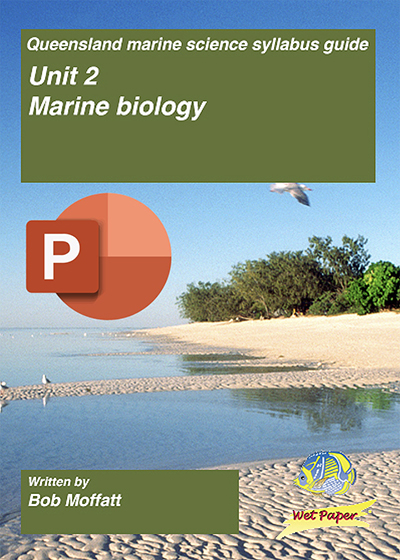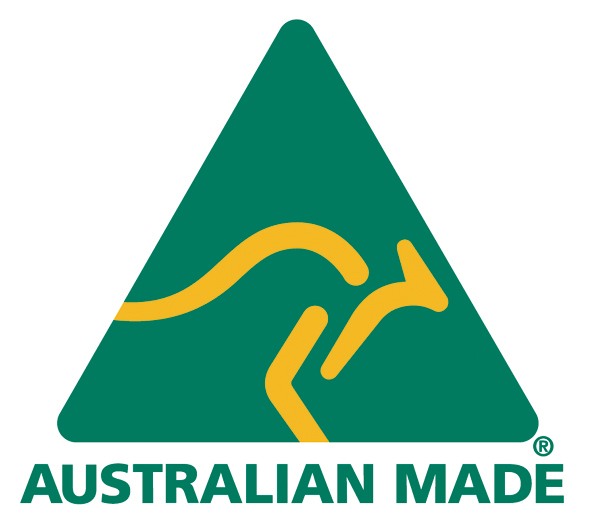Marine biology for senior students power points

ISBN : 978-1-86283-172-8 (E Pub)
Published Date : 03 December 2018
Product Code : F 48PP
Format : Zip file of 32 power points with licence agreement
By Bob Moffatt
Wet Paper publications non-commercial school licence
The publisher and author/s of this pdf file grant to the school a revocable, non-exclusive, non-transferable right and licence to use the content, exercises, lab and field work lesson notes within the school for educational purposes only.
Yearly record keeping
To ensure fair payment is made to collecting societies, educational institutions are to record the digital ISBN above.
- To do this go to the school office and ask the IT department or whoever looks after digital book licences to record the ISBN in the school digital library licence catalogue.
Copyright
Except as permitted by the Copyright Act 1968 (Cth), you may not reproduce any of the contents of this publication, without the written permission of the copyright owner.
The title to, and intellectual property rests with the publisher's author/s, illustrators, photographers and design consultants and nothing in the agreement should be construed as transferring those rights to the school.
Educational exemption
There are exemptions under the Act that allow educational and government use of text, images and music scores for educational purposes.
These exemptions are in Part VB of the Copyright Act 1968 (Cth), where you are entitled to reproduce or communicate 10% of the words or one chapter from this file for educational use within your school. If you wish to reproduce or communicate MORE than 10% contact the copyright owner.
For more information, see www.copyright.com.au and www.copyright.org.au.
Teachers Information
Suitable for Unit 2 Qld Marine Science Syllabus topics 1 and 2
Note: This is a 440 Mb file with 32 power points a containing over 1100 slides of Bob's original work.
Citation
This publication should be cited and acknowledged as:
Queensland Marine Science Syllabus Guide V1.2 Unit 2 Marine Biology, written by Bob Moffatt, Wet Paper Publications 2019
Self-funding legacy
This Wet Paper legacy project is self-funded from the sales of a small number of books to allow future marine educators to take our original ideas from 2021 and make them relevant in 5, 10 or even 20 years in the future.
Copyright
The Moffatt Group Australia Pty Ltd 2020.
Price
The publication is FREE.
Contents
1075 power point slides with activities, experiments and projects for the new syllabus.
Unit 2: Marine biology
Topic 1: Marine ecology and biodiversity
A. Biodiversity
Power point titles
T037 Three diversity types
T038 Biodiversity characteristics
T039 Australian marine ecosystems
T040 Connectivity in marine ecosystems
T041 Diversity loss factors
T042 Simpson’s diversity index
T043 Apply biodiversity data
T044 Important ecosystem definitions
Syllabus subject matter statements
T 037 Define the three main types of diversity (i.e. genetic, species, and ecosystem)
T 038 Recall the three unique characteristics of marine biodiversity (i.e. wide dispersal at sea, the need for structural complexity, critical nursery habitats)
T 039 Identify the variety of ecosystems (e.g. estuaries, coastal lakes, saltmarshes, mangroves, seagrass, rocky shores, temperate reefs, coral reefs, lagoons, shelf and deep water) that constitute Australia’s marine biomes
T 040 Describe the implications of connectivity to marine ecosystems
T 041 Identify factors that lead to a loss of diversity (e.g. natural hazard, loss/fragmentation of habitat, pollution, exploitation, introduction of new species, disease)
T 042 Calculate the biodiversity of a marine ecosystem using Simpson’s diversity index (SDI)
T 043 Apply data to determine the biodiversity of a marine ecosystem using diversity indices
T 044 Ecosystem resilience, disturbance and recovery.
Biotic components of marine ecosystems
S08 Biotic components of marine ecosystems - power point titles
T045 Biotic components of ecosystems
T046 Biotic interactions in ecosystems
T047 Trophic level classifications
T048 Food web matter cycling
T049 Population terms
T050 Assess population data
Subject matter statements
T 045 Identify biotic components of marine ecosystems (i.e. trophic levels, food chains, food webs, interactions and population dynamics)
T 046 Categorise biotic interactions based on the following terms: symbiosis (i.e. parasitism, mutualism, commensalism and amensalism) competition (i.e. intraspecific and interspecific) predation
T 047 Classify organisms in trophic levels in a food web based on the following terms: producers, primary consumers, secondary consumers, tertiary consumers, decomposers.
T 048 Describe how matter cycles through food webs, including the process of bioaccumulation
T 049 Recall the terms: population size, density, abundance, distribution (i.e. clumped, uniform, random), carrying capacity, niche, K-strategists and r-strategists, keystone species
T 050 Assess population data to measure population size, density, abundance, distribution, carrying capacity.
Abiotic components of the marine ecosystem
S09 Abiotic components of marine ecosystems - power point titles
T051 Air and water comparisons
T052 Abiotic factors of marine ecosystems
T053 Limiting factors and tolerance limits
T054 Assess tolerance limit data
T055 Apply zonation concepts
T056 Population dynamic investigation
Subject matter statements
T 051 Understand that marine ecosystems are influenced and limited by abiotic factors in ways that may be different from terrestrial ecosystems due to the different physical and chemical properties of water compared to air
T 052 Distinguish abiotic components of marine ecosystems: light availability, depth, stratification, temperature, currents (water and wind), tides, sediment type and nutrient availability
T 053 Understand the importance of limiting factors and tolerance limits in population distributions
T 054 Assess data to identify an organism’s tolerance limit
T 055 Apply the concept of zonation using the following terms: intertidal, pelagic (neritic, oceanic), benthic and abyss.
T 056 Conduct an investigation to determine factors of population dynamics (e.g. density or distribution) and assess abiotic components of a local ecosystem case study. Emphasis should be placed on assessing the processes and limitations of the chosen technique (e.g. quadrat, transect). When students identify and describe marine species, they should use field guides and identification keys. (Mandatory practical).
Adaptation
S10 Adaptation - power point titles
T057 Categorise animal groups
T058 Types of adaptations
T059 Adaptations and survival
Subject matter statements
T 057 Categorise different groups of animals using structural characteristics
T 058 Identify and classify adaptations as anatomical (structural), physiological (functional) or behavioural
T 059 Describe the role of adaptation in enhancing an organism’s survival in a specific marine environment.
Topic 2: Marine environmental management
A. Marine conservation
Power point titles
T060 Species and habitat preservation
T061 Marine ecosystem values
T062 Stakeholder roles
T063 Stakeholder value systems
T064 Marine ecosystem issues
T065 Ecosystem health case study
Syllabus subject matter statements
T 060 Recall the arguments for preserving species and habitats (i.e. ecological, economic, social, aesthetic, ethical)
T 061 Describe the direct and indirect values of marine ecosystems of Australia
T 062 Describe the role of stakeholders in the use and management of marine ecosystems
T 063 Discuss the specific value systems that identified stakeholders use (i.e. ecocentric, technocentric, anthropogenic)
T 064 Recognise the issues affecting a selected marine ecosystem
T 065 Apply the terms ecosystem resilience, disturbance and recovery as indicators of ‘health’ of marine environments to a chosen case study.
B. Resources and sustainable use
Power point titles
T066 Precautionary principle
T067 MPA design criteria I
T068 MPA planning
T069 MPA evaluation
Syllabus subject matter statements
T 066 Recall the precautionary principle of the marine environmental planning and management process as well as a requirement that any network of marine protected areas be comprehensive, adequate and representative
T 067 Understand that criteria are used to inform decisions regarding the design of protected marine areas
T 068 Compare the strategies and techniques used for marine environmental planning and management with reference to a specific case study
T 069 Evaluate the marine environmental planning and management process using primary or secondary data of a specific case study (this may be linked to fieldwork).




